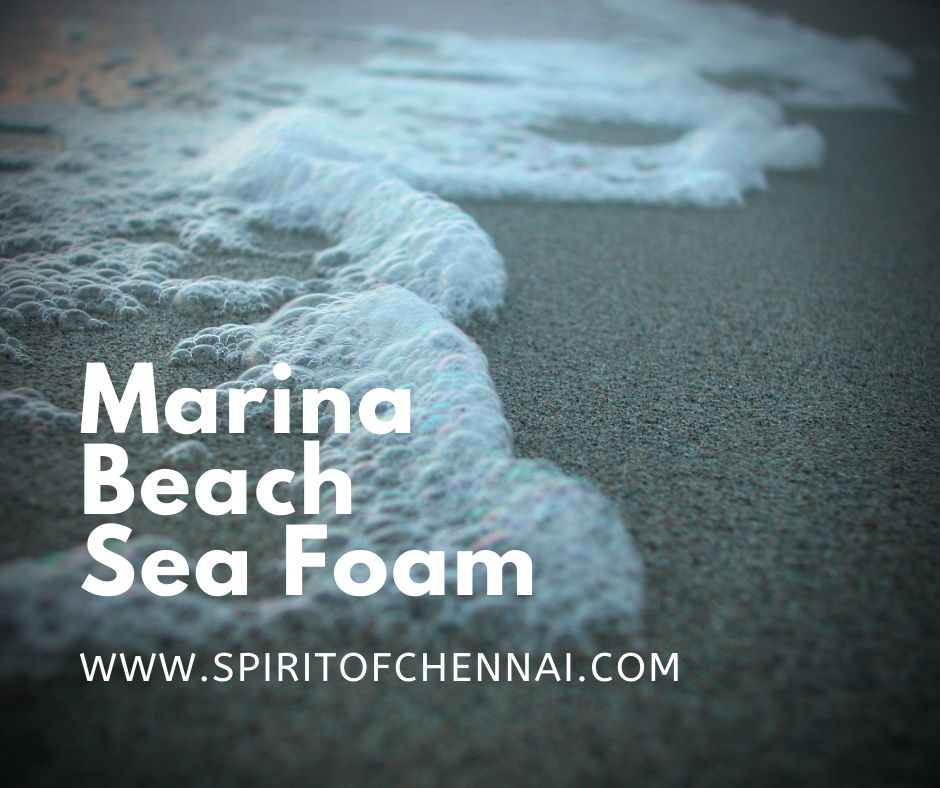Marina Beach Sea Foam of December, 2019 took many by surprise!
Sometime last weekend, the beaches of Chennai, especially Marina Beach witnessed huge mass of white foamy matter covering the coastlines.

But for many, especially the neighborhood community fisherman, this is not a surprise. Chennai received this sea foam yearly occurrence during monsoons.
With Marina beach being one of the main attractions in Chennai, people are visiting the beaches and maybe even enjoying the seemingly harmless foamy waters thrown up by the breaking waves.
According to National Centre for Coastal Research (NCCR), this time around the foam was caused due to mixing of Sewage and the high tidal movement only churns the sea water to cause foam. This time it extended for 50 feet from the shoreline.
According to the Indian Express, a spokesperson from the local Pollution Control Board says the foams are caused by untreated waste water from the factories released into the sea directly and also monsoon rain water carrying the city’s pollution. Only 40% of Chennai’s waste water is treated and the rest gets into the sea as is.
Residents and visitors have been cautioned to not get into the foamy waters as it may cause skin irritation and other such health hazards but and people in general and children especially just want to have fun.
Fishermen have also been warned to stay away from the sea, as a precaution. Fish prices have gone down drastically these days say the local fisherman as people are suspicious of contamination from the foamy waters.
What causes Sea Foam?
Sea foam also known as spume is mainly created by agitating sea waters, particularly when it contains higher concentrations of dissolved organic matter. These are derived mainly from breakdown or decay of algal bloom. These compounds act as surfing agents or can be called as natural detergents present on sea surface.
Foaming waters is a global phenomenon and varies from place to place depending on the surrounding marine and terrestrial environment.
The composition of sea foam is a mixture of decomposed organic materials like algae, planktons, bacteria, fungi and vascular plants. The main component of sea foam is found to be protein in many areas. Old and new foam contained high concentration of proteins than other minerals coming from decaying matter. Old foam is also found to have higher concentrations of bacteria which would feed on the protein content.
Sea foams can be of two kinds depending on their stability or longevity. The unstable, transient foams last only for a few seconds and burst releasing aerosols into the air causing what is called sea sprays.
The metastable foams may last up to hours to several days and are categorized as metastable sea foam. They contain small particles of silica, calcium and iron which contribute to the bubble’s longevity. Also, the dissolved organic material released by decomposing seaweeds, algae, planktons etc contribute to the longevity of the foam created by agitating seawaters. The protein from these components adds stiffness to the water bubble surface similar to how proteins in egg whites when whipped up creates stiff peaks in the foam.
Sea foam acts as a food source and provides habitat in the marine environment. It also acts as a mode of transport for the nutrients and microorganisms. As sea foam is a wet environment, able to sustain its texture for a longer time, it is conducive for growth and transportation of algal spores.
Is Sea Foam Toxic?
Sea foams that naturally occur are not toxic of itself!
But, Industrial Waste and Chemical Effluents filled Sea Foams are Toxic!
When created due to high concentrations of decaying algal matter and other bubble surface microlayers like fossil fuel and storm water run offs, they can become toxic to some extent.
As per section 25 of the Water (Prevention and Control of Pollution) Act, 1974 as amended in 1978 & 1988 “Consent of the Tamilnadu Pollution Control Board for the establishment / operation of any industry and for discharge of sewage / trade effluent into any stream or well or sewer or on land or into marine coastal areas to be obtained. (List of industries for which the Tamil Nadu Electricity Board has to give power supply only after the industries produce consent to establish order issued by the Tamil Nadu Pollution Control Board is given in GO MS No. 111 E&F Dept. Dated 21.9.2011)”.
The aerosol released when these foams burst or dissipate can affect the lungs and skin of those exposed and also eye irritation. People suffering from respiratory conditions like asthma may find their condition worsened after such an exposure at the beach.
A study done in 2007 of mass die-offs of seabird in California and 2009 in Pacific Northwest found that there was a soap-like foam layer on the feathers of these birds that had caused removal of waterproofing and made it harder for these birds to fly. This led to hypothermia in these birds that resulted in the high fatality rate.
Sea Water Pollution
Water is one of our most precious natural resource and clean water is a basic necessity for a thriving life. However, pollution of our water bodies is by far the biggest problem facing our planet today and the consequences threaten our very existence.
Unfortunately, we humans as a whole are doing very little to conserve our environment but are mostly destroying it.
It is said that 80% of the world’s waste water is dumped, untreated, back into the environment, polluting the lakes, rivers and ultimately the oceans. We are damaging our fresh water and sea water resources. The contaminants produced by our factories such as chemicals and heavy metals are directly dumped into bays and estuaries from where they are directed into the ocean.
Marine debris, mostly plastic, an unrecyclable pollutant, also finds its way into the oceans. The other kinds of sea pollutants are debris from oil spills.
The fast paced growth of human civilization in the recent decades has come to us at a huge cost.
Unless we stop further contamination and destruction of our environment, the damage would be irrevocable and our future generations will be faced with a bleak future.
Conclusion
The oceans cover 71% of our planet and most of it is inaccessible to the common man but even though the deep sea may seem out of reach to most of us, the imbalance caused to the marine ecosystem due to pollution has lasting consequences on us.
As learned men and women, we have a responsibility towards the ecosystem we live in and we definitely owe it to our children to give them a clean and self-sustaining environment.


